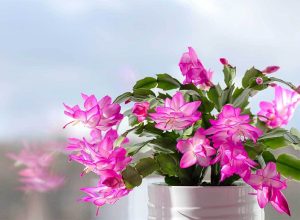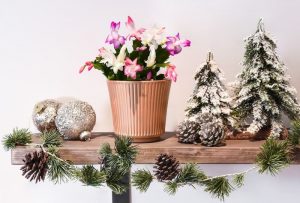The Christmas cactus (Schlumbergera spp.) is a popular holiday plant known for its vibrant blooms that add a festive touch to any indoor space. With proper care, this tropical beauty can thrive indoors, providing colorful flowers every year during the holiday season. Here’s an extensive guide to help you master how to care for Christmas cactus flowers when growing indoors, ensuring your plant remains healthy and blooms abundantly.
1. Provide the Right Lighting
Unlike many succulents, the Christmas cactus does not tolerate harsh, direct sunlight. Instead, it thrives in bright but indirect light. Place your plant near a north- or east-facing window where it can soak up enough sunlight without scorching its leaves.

During winter, when natural daylight diminishes, supplement with fluorescent grow lights to provide 8-10 hours of light daily. If your plant is exposed to excessive direct sunlight, it may develop yellowish foliage and suffer from stunted growth, so be sure to shield it with sheer curtains if needed.
2. Master the Watering Schedule
Watering a Christmas cactus requires balance to avoid two common pitfalls: overwatering and underwatering. Check the top inch of soil for dryness before watering. When it feels dry, water thoroughly, allowing excess water to drain out of the pot. Never let the plant sit in standing water, as this can lead to root rot.
During the blooming phase, Christmas cacti prefer slightly more moisture. However, as soon as the flowering period ends, reduce watering gradually to allow the plant to enter a rest phase. In drier environments, consider misting the plant occasionally to maintain humidity.
3. Maintain Ideal Temperature and Humidity
Christmas cacti thrive in moderate indoor temperatures between 65°F and 75°F during the day and around 55°F to 60°F at night. Cooler nighttime temperatures help trigger flower bud formation, so avoid placing your plant near heating vents or radiators.

These plants are native to tropical rainforests, so they prefer higher humidity levels than typical succulents. Use a humidifier, group it with other plants, or place a shallow tray filled with water and pebbles nearby to boost humidity.
4. Fertilize for Vibrant Growth and Blooms
Fertilizing your Christmas cactus is essential for healthy growth and flower production. During the active growing season (spring and summer), feed the plant monthly with a balanced, water-soluble fertilizer, such as a 20-20-20 formula.

As the fall months approach (late September to early October), stop fertilizing to encourage the plant to prepare for blooming. During this period, it’s critical to let the plant rest by reducing watering and maintaining cooler nighttime temperatures.
5. How to Encourage Flowering Indoors
Achieving vibrant blooms during the holiday season requires replicating the plant’s natural growth cycle. Here’s how:
- Short-Day Treatment: Christmas cacti are short-day plants, meaning they require extended periods of darkness to flower. From mid-October, ensure the plant receives 12-14 hours of uninterrupted darkness each night for about six weeks. Cover it with a dark cloth or place it in a room without artificial light.

- Cool Temperatures: Lower the nighttime temperature to around 50°F to 55°F to stimulate bud formation.
Once buds begin to form, resume regular care, including increased watering, light exposure, and stable indoor temperatures. Avoid moving the plant during this stage, as changes in its environment can cause buds to drop.
6. Choose the Right Soil and Potting Mix
A well-draining potting mix is vital for a healthy Christmas cactus. Use a mix designed for cacti and succulents or create your own by combining equal parts potting soil, sand, and perlite.

Repot your Christmas cactus every 2-3 years, preferably in spring after the blooming period. Choose a pot only slightly larger than the current one, as these plants bloom better when their roots are slightly crowded.
7. Manage Common Pests and Diseases
While Christmas cacti are generally hardy, they can fall victim to pests like mealybugs, spider mites, and fungus gnats. Inspect your plant regularly and wipe off pests using a cotton swab dipped in rubbing alcohol. For severe infestations, use neem oil or insecticidal soap.
Root rot is another common issue, often caused by overwatering or poor drainage. If you notice yellowing leaves or mushy roots, trim the affected parts and repot the plant in fresh, dry soil.
8. Winter Care for Christmas Cactus
Winter is a critical time for the Christmas cactus, especially when it’s indoors. To help the plant thrive:

- Avoid placing it near drafty windows, heating vents, or fireplaces, as these can cause stress.
- Ensure consistent watering, humidity, and light conditions to prevent the buds from dropping prematurely.
- Rotate the plant periodically so all sides receive equal light exposure, but avoid moving it once buds appear.
9. After-Bloom Care
Once the flowering period ends, the Christmas cactus enters a rest phase. During this time, reduce watering and keep the plant in a cooler spot with minimal light exposure. This rest period typically lasts 6-8 weeks. Gradually resume regular care as new growth appears in late winter or early spring.

Caring for a Christmas cactus indoors may require attention to detail, but the reward of seeing its vibrant flowers during the holidays is well worth the effort. By providing the right light, watering, temperature, and fertilization, and by understanding its blooming cycle, you can enjoy this festive plant year after year.
Whether you’re a seasoned plant enthusiast or a beginner, following these tips will help you nurture a thriving Christmas cactus that becomes the centerpiece of your holiday décor. Start caring for your Christmas cactus today and enjoy its beauty as a reminder of nature’s magic during the festive season!

